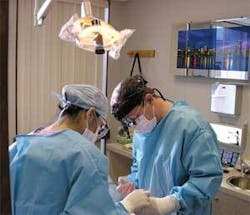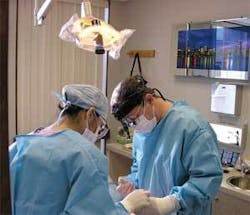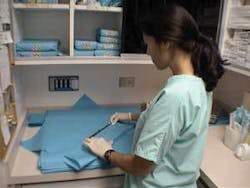stealth technology
How to increase profits with simple, time-saving instrument management techniques and tools ...
As dental practitioners, we are both health-care providers and small-business owners. In that dual role, it is imperative that we provide the highest quality of care for our patients and run a profitable business. This balancing act requires constant attentiveness and regular evaluation of the efficiency of the practice while also cultivating a safer, more enjoyable working environment. We often ask ourselves this question: How can we use new technologies as tools to help us increase profits and quality of patient care, while enhancing the work environment of our staff?
When considering investment opportunities such as a new piece of equipment, software, or practice-management tool, I always carefully consider the value of that purchase to our practice. Over the years, I have found that this value can be measured as either tangible or intangible. In terms of the intangibles, I consider the following questions: Will the investment save time? Will it provide better protection for my dental team? Will this investment allow for a higher quality of patient care?
While appreciating intangible benefits, a return on investment is often essential for a practice to move forward.
Several unique investments could have significant invisible impact on an individual practitioner’s bottom line. I call these investments “stealth technologies” - their benefits are almost invisible.Because they are not considered “hot” or “new,” they are almost hidden from the doctor’s radar screen. Yet, they contribute greatly to the column of tangible benefits; these technologies should be given every consideration as investments.
One of the “stealth technologies” that has changed my entire practice has been Hu-Friedy’s Instrument Management System, IMS (cassettes). It has truly added both tangible and intangible value to every aspect of my practice, from the front office to the operatories to the sterilization room.
IMS is not a trendy topic like digital radiography, lasers, or CAD/CAM. It is “stealth technology” because many practitioners do not view IMS as “equipment.” But when this well-designed system is properly implemented, it can have a direct and dramatically favorable impact on an office’s bottom line.
Let me start by explaining the system’s intangible benefits (those not measured in dollars). First, we used IMS to create a “process change.” With the new system in place, we created standardized set-ups that are managed as a single unit in the cassette. This allows for faster set-up, tear-down, chairside accessibility of instruments, and faster cleaning and reprocessing. Since implementing IMS, my practice has been enhanced by several intangible stress-reducing benefits. (See Table 1.) I also calculated tangible benefits of the IMS system via a number of incremental revenue factors that must also take into account the investment cost required to implement the system. I find that a “break-even” target of less than 12 months is an acceptable period.
I use these six factors to calculate return on investment:
1) Processing time savings
2) Increased doctor production
3) Reduced instrument and consumable costs
4) Reduced overtime
5) Reduced turnover/training
6) Increased patient load/improved marketing
Processing time savings
Instrument processing is very efficient and safe with IMS. We have found that five minutes per procedure is saved during the reprocessing of instruments. In addition, breakdown and set-up of operatories are faster with IMS. Table 2 shows our savings in minutes per patient.
Increased doctor production
Saving five minutes per patient is an advantage. However, this tactic alone is not the key to adding patients to a daily schedule. In addition, alternate scheduling strategies can offer viable solutions.
For example, our postop patients are often finished with their check-ups in less time than expected, allowing us time to schedule more of these visits. This leaves a larger available time-unit at the end of a day, enough time to schedule another production procedure.
We have found we can gain 30 minutes per doctor. (220 days per year at a rate of $300 per hour calculates to an incremental revenue of $66,000.)
Reduced instrument and consumable costs
Every dental practice makes a significant investment in instruments. Maintaining instruments so they last longer clearly saves money and is reflected on the bottom line. In the IMS cassette system, instruments are held apart to prevent damage from rubbing and scraping during processing. We have also found that with the IMS, we can minimize the chance of lost or misplaced instruments. Overall, we estimate that our savings on periodontal instruments is about 50 percent. (Annual instrument expenditure of $1,800 x 50 percent = $900.)
How can a cassette be justified over a pouch? With IMS cassettes, you can assemble an entire set-up in a single package rather than manage numerous pouches. You do not need a tray cover or spray to disinfect the tray. We estimate that, per procedure, IMS cassettes have helped us cut our consumable costs by one-third on average.
Reduced overtime
With a faster cleanup of rooms and a highly efficient reprocessing protocol, the staff saves time during the day and after hours. Laboratory and other maintenance chores are completed during patient hours. Thus, team members punch the clock sooner, saving hours in salary each month. (We have calculated close to $4,800 per year reduction in overtime.)
Less turnover
A study by the Levin Group in the August 2005 issue of Contemporary Esthetics and Restorative Practice found that the replacement of a well-trained front-desk staff person can cost a practice more than $36,000 per year in lost productivity. Though the study did not provide the figures pertaining to the cost of replacing an assistant, presumably turnover costs would be comparable - perhaps more, since these positions are critical to patient care, relationships, and overall productivity of an office.
Interestingly, in our office the IMS system has promoted camaraderie and teamwork. The system’s simplicity encourages the hygiene and reception staff to help with instrument processing.
Increased patient load/improved marketing
Once the efficiency of IMS has created more time in the schedule, how do we find new patients to fill these open appointments? At this point, the key is marketing. IMS provides an outstanding way to demonstrate how your practice excels in caring for the safety and well-being of both staff members and patients! Our office includes a simple description of IMS in our New Patient Brochure, on our Web site, and in patient newsletters. We also discuss the system during consultations, and we often take new patients on a tour of the sterilization facilities.
Last year, four new-patient referrals were the direct result of marketing with sterilization as a key component. (Based on our average revenue of $2,000 per patient, the incremental revenue was $8,000.) The investment is more than offset by the savings my office has realized in using the system.
Each individual practitioner will see a different financial impact based on how his or her office is managed. In the 16 years we have used the IMS system, I believe the intangible benefits were sufficient to justify its purchase. When the intangible benefits of patient and staff loyalty are considered in combination with the fiscal and operational benefits, it should satisfy the business owner in all of us. Sometimes the best solutions are right in front of us - under the radar screen.
Peter Haupers Jr., DDS, MS, MBA, has been in the private practice of periodontics in Chicago since 1978. A graduate of Loyola University School of Dentistry and its graduate periodontal program, Dr. Haupers is a past president of the Illinois Society of Periodontists. He received a master’s degree in business administration from Northwestern University Kellogg School of Business in 1998. You may contact Dr. Haupers by e-mail at [email protected].




